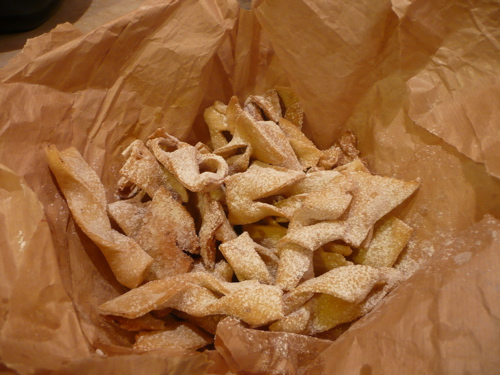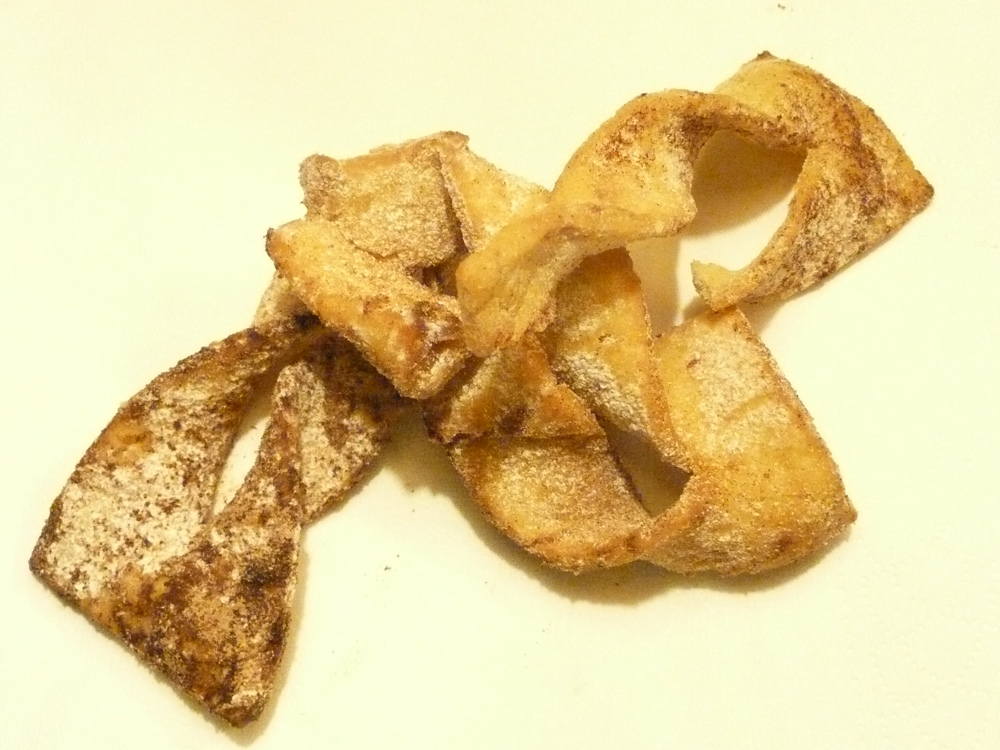Martedi Gras- Fat Tuesday or in Italy, Martedi Grasso. What is the perfect food to celebrate?

Something fried of course!
All over Italy, someone is frying up sweets. Often with the same shape, but a different name.
Here in Florence, we have Cenci, which means rags, like the shape they have, which looks like torn cloth.
In Liguria and other areas, there are Bugie, little lies or Chiacchere, small talk.
My grandmother was born in Tiblisi, Georgia and moved to Shanghai when she was very young as many did.
One of the recipes I remember her making was Khvorost, a fried cookie made with Vodka in the dough. I was amazed when I came to Italy to see my grandmother’s cookie, but made with the Tuscan dessert wine, Vin Santo.
So in honor of my grandmother today I used Vodka!

Ingredients
- 2 cups 00 flour
- 2 tbs granulated sugar
- 2 tbs olive oil ( russians would use sour cream)
- 2 whole eggs, beaten
- grated orange rind
- 4 tbs vodka
- pinch of salt
- powdered sugar( for dusting after)
- oil for frying
Instructions
- Mix all the dough ingredients together, adding as much vodka as needed to make a nice firm dough you can knead.
- Knead the dough until it is soft and not sticky.
- Let rest for 20 minutes.
- Roll the dough out as thin as possible.
- Cut strips, 2 wide and cut an opening in the dough, leaving the ends attached.
- Pull one end of the dough through the opening, twisting the dough.
- Fry until lightly golden.I fried mine till golden in extra virgin olive oil ( because I can!).But sunflower or corn oil is fine
- Dust with powdered or granulated sugar and serve.

Hey – I was just explaining in a post to the the uk.food+drink.misc readers about Polish “chrust” (kindling – when stacked up it looks like a small camp fire ;))) )…and someone pointed us to your blog – rags, kindling – it’s all the same and tastes wonderful!
For some reason one of the chrust schools tells you to whack the dough with a rolling pin to get as much air out as possible – our friends’ little granddaughter helped her Granny by beating the dough with her plaster (she had her arm in plaster)!!!!!!
Lovely blog!
cheers,
Krysia
I love it!
one more name for the same cookie!
I remember beating the dough too!
Here in Italy using the basic flour we have, “OO”, it is more like a soft pastry flour, so easier to make than using al all purpose flour!
I found that letting the dough sit, and using a pasta machine to roll out the dough , I got great results!
Funny thing about that cookie – everyone makes it, don’t they? My grandmother, Angela Barra Crocetti used to arrive at our house with boxes of her “Crostoli”, and of course we devoured them. I recall that in 12th grade civics at Palisade High our teacher brought some cookies his Lithuanian mother made. He opened the container, and I said “Oh, crostoli!” Mr. Karalius said “No.” And then spoke the Lithuanian name for the cookie. It was really a surprise to learn that so many folks made them. Then another student spoke up and said her Jewish grandmother made the cookies. So I guess fried dough is universally popular. Thanks, Judy for sharing your family’s version. I love seeing other families food traditions.
@adri even in italy the name changed region to region- I would not know crostoli! here they are cenci! but frappe, chiacchiere… fried it fab!
Wright pronouncing in Russian is “Chvorost” – it’s mean that pieces of ready crust are crackling like dry branches of trees.
Thank you Divina!